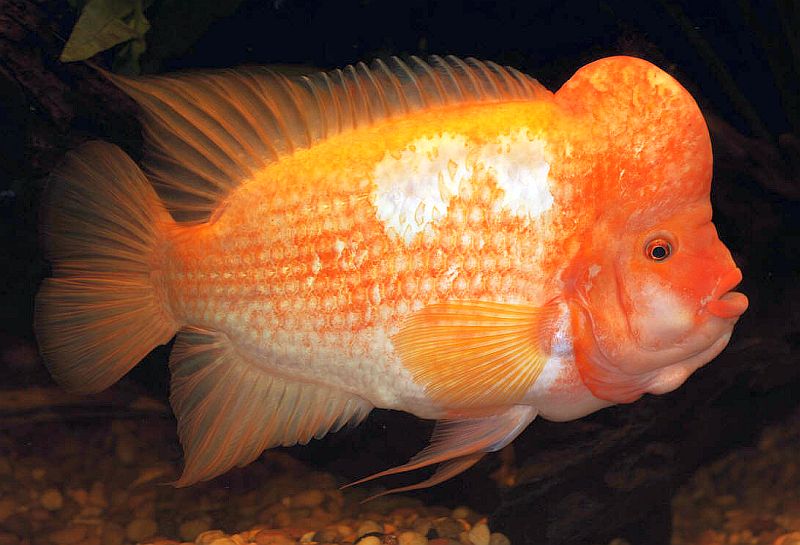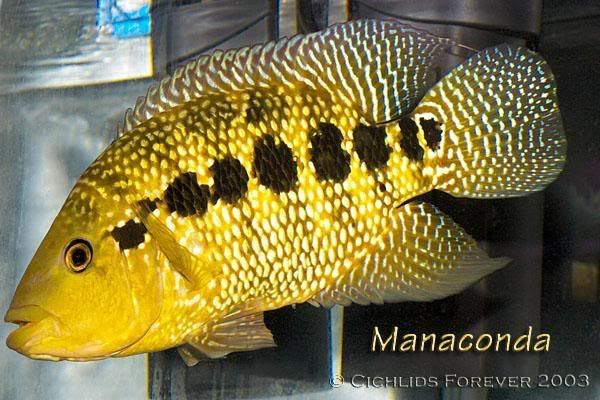
+- WildFact (https://wildfact.com/forum)
+-- Forum: Information Section (https://wildfact.com/forum/forum-information-section)
+--- Forum: Aquatic Animals and Amphibians (https://wildfact.com/forum/forum-aquatic-animals-and-amphibians)
+--- Thread: River and lake (/topic-river-and-lake)
RE: River and lake - Pckts - 12-18-2016
Oddly enough, African cichlids are smaller and far less aggressive. But they do have a huge variety of color.
RE: River and lake - Pckts - 04-14-2017
Some more aggressive Cichlid info...
Arguably the most aggressive genus of cichlids lb for lb are known as Amphilophus
Here's a few bellow
One of the most famous tank cichlids other than an Oscar is Known as a Red Devil, but really a Red Devil cichlid is usually a Hybrid, the non hybrid version is known as a Midas Cichlid or A. citrinellus

*This image is copyright of its original author

*This image is copyright of its original author

*This image is copyright of its original author
My favorite amphiliphous is called a Trimac
*This image is copyright of its original author

*This image is copyright of its original author
*This image is copyright of its original author
The largest of the amphiliphous is called the Chancho Cichlid and these guys are big, not as big as a Dovii or Umbee but still very big and robust.
*This image is copyright of its original author
*This image is copyright of its original author
*This image is copyright of its original author
While these guys don't possess the equipment that the parachromis genus does they make up for it with attitude. They will usually dominate tanks of equal sized fish and can even play a "status quo" role, they'll usually keep everyone else in line. They are almost "hyena like" with their short spines and blunt front feature, like a battering ram.
RE: River and lake - Jimmy - 04-14-2017
@Pckts Nice to read your information and pictures on beautiful Central American cichlids. You said that Africans are far less aggressive cichlids. However, I think African cichlids are lesser in size-aquarium varieties so they tend to be more cautious. In my view African are more harassing type of cichlid while americans are more predatory type. In terms of equal size i think african are more notorious. They are cleverer in fights maneuvering sideways, launching from bottom as well. American tend to be more calculating, slightly slower and tend to look for lip locking style. I used to have a Demasoni cichlid who always made green terror hide behind a rock, if they fought the Green terror would look for a more calculating move often lethargic while demasoni was more agile would make a rapid movement and gestures hitting from anywhere. After that i had Yellow lab who would beat salvini of the same size in length but salvini obviously being more bulky. i was unaware about cichlid's temperament and learned the hard way... cichlids are tough fish to maintain in a community even among them. Now i have barbs and danios in Perfect harmony!!
here is a big emperor cichlid parents from africa challenging a terrapin..
RE: River and lake - Pckts - 04-14-2017
Valid point @Jimmy
I think most Africans just aren't equipped to do damage, even the emperor Cichlid ( largest Cichlid in the world) doesn't possess the fangs or attitude of its Central America cousin but it's certainly not going to shy away from a fight. But green terrors or salving are small less aggressive cichlids compared to other small aggressive c. American cichlids like a grammode, istlantum, convict etc. which will eliminate any similar sized tank mates but they still will usually have a size advantage over most African's but IMO, one of the toughest Cichlids on earth is also one of the smaller ones... the convict cichlid.
BTw, glad to hear of another fish keeper on here, salvinis are very cool.
RE: River and lake - Jimmy - 04-14-2017
Thank you @Pckts and yes i am a great fan of cichlids in particular they have such characters. Salvini is one of my favourite, brilliantly coloured, good natured (defensive rather than aggressive in my view) and more of all demands little space. I am slighly amaged that you regard convicts that high, i know they are badass but i kinda think they would be similar to jewels who i rate as behind Mbunas in terms of aggression, agility and fighting although they are great nippers. Have you mixed african and American cichlids yourself or you know this by research. In it's size range i think Auratus are really the bullies but i take your word since you have much knowledge on cichlids.
RE: River and lake - Pckts - 04-14-2017
Yes, I like most started with an African setup, eventually graduated to green terrors and oscars then saw my first "red devil" in action, it opened my eyes to a whole new world. Haha
Once I found a website where I could buy more exotic and aggressive fish, I was hooked. Here's a story on convicts and a mixed tank I had.
I always thought convicts were overrated until I owned one, I had a pair with some Africans a green terror and a jaguar until the jag got larger and picked them all off except my convict pair, eventually the jag got the female but for the longest time my male was able to avoid and return aggression, even started to grow, develop a nuchal hump and nice blue undertone, I thought they may even coexist, but eventually my jag got him but seeing that lil guy in action made me a believer. After reading similar experierences, I'm sold.
Btw, a great forum is called monsterfishkeepers.com, check it out. I'm on there as well, although not nearly as active but if you search my same name you'll be able to see some of my fish plus much, much more.
RE: River and lake - Jimmy - 04-14-2017
Started to develop nuchal hump and return aggression..haha that too against Jag, great little fish no doubt.
RE: River and lake - Pckts - 04-20-2017
RE: River and lake - Pckts - 04-20-2017
RE: River and lake - Jimmy - 04-22-2017
I can see why many cichlid lovers are in-amoured by Fastaes. These are absolutely brilliant, second to none interms of colouring. Maybe Discus, Salvini, Rams and some Arrowanas in that order. But those red terrors are the best of the lot. .... Nice to see them get mentioned.
RE: River and lake - Pckts - 04-22-2017
(04-22-2017, 04:39 PM)Jimmy Wrote: I can see why many cichlid lovers are in-amoured by Fastaes. These are absolutely brilliant, second to none interms of colouring. Maybe Discus, Salvini, Rams and some Arrowanas in that order. But those red terrors are the best of the lot. .... Nice to see them get mentioned.
Not that I approve of hybrids but may be the most beautiful hybrid I've ever seen was a Festae x Jaguar mix

*This image is copyright of its original author
the Dovii x festae mix is pretty cool as well

*This image is copyright of its original author
RE: River and lake - Pantherinae - 04-23-2017
RE: River and lake - epaiva - 04-24-2017
(12-12-2016, 06:34 PM)parvez Wrote: Outsized jaw muscles allow the black piranha to exert bite force equivalent to 30 times its bodyweight, a feat unmatched in the natural world, according to results of a finger-risking study.
Other animals like the great white shark, the hyena and the alligator can deliver more forceful bites, but their crunching power becomes much less impressive when viewed in relation to their overall size and weight, researchers said.
In fact, relative to their size, piranhas outperform even prehistoric monsters like Tyrannosaurus rex and the whale-chomping megalodon, a massive shark that preceded the great white, said the study.
Published in the journal Scientific Reports, the research saw scientists catch 15 black piranhas in Brazil's Amazon River basin and risk their digits by teasing a customised force gauge between their serrated jaws.
The fish, ranging from about 20 to 37 centimetres (eight to 15 inches) in length, 'readily performed multiple defensive bites' on the gadget, wrote the team from the United States, Egypt and Brazil.
This was the first live measurement of bite force taken from the black piranha (Serrasalmus rhombeus), the largest of the notoriously carnivorous species.
Such undertakings are 'rare, dangerous and difficult to perform,' wrote the research team.
'While anecdotes of piranha-infested waters skeletonising hapless victims are generally hyperbole, the effectiveness of their bite is not,' the scientists added.
They pointed to 'documented cases of S. rhombeus biting off and consuming human phalanges' - the bones found in fingers and toes.
The measured bite force of the black piranha, at 320 newton (N), was nearly three times greater than that exerted by an American alligator of comparative size, said the study.
One newton is the force required to move a kilogramme (2.2 pounds) of mass at one metre (3.25 feet) per second squared.
It has jaw muscles of an 'extraordinary' size and a highly modified jaw-closing lever, said the team.
In fact, the muscle complex makes more than two percent of the black piranha's total body mass.
The team also used the data they gathered to estimate the bite force of the extinct Megapiranha paranensis to have been between 1,240 and 4,749 N.
The fish from the Miocene period, which ended about five million years ago, would have been about 70 centimetres long and weighed about 10 kilogrammes (22 pounds), they said.
Our analysis predicts Megapiranha's bite was equivalent to the anterior bite force of a great white shark weighing over 400 kilos (880 pounds)," said the report.
And though their diet remains a secret of history, the monster fish would have been able to crush turtles, armoured catfish and even larger terrestrial animals.
'If our fossil reconstructions and simulations are correct, then Megapiranha paranensis was indeed a ferocious bone-crushing mega-predator of the Miocene epoch,' just like its modern-day relative, said the report.
'Our results for living and extinct species validate the fearsome predatory reputations of piranhas.'
http://www.dailymail.co.uk/sciencetech/article-2251768/The-black-piranha-powerful-bite-animal-history--T-Rex--researchers-find.html
It would be great if they measure the bite force of the Pygocentrus piranhas (Pygocentrus piraya, Pygocentrus cariba and Pygocentrus nattereri) the group of Piranhas that attack in huge numbers, I am sure they bite harder than the Black piranha (Serrasalmus rhombeus).
RE: River and lake - Pantherinae - 06-14-2017
Hey @Pckts and others I have a friend who brought a bunch of Parachromis Loiselle, but now that they have grown two stands out, and does not at all look like a Loiselle... I could not answer him and I'll post pictures he sent me and maybe someone knows..

*This image is copyright of its original author
Here is The Loiselle 
*This image is copyright of its original author
And here is the other guy.
RE: River and lake - Pckts - 06-15-2017
It's really hard to ID at such a young age, I'd guess Loisellei or even a Motaguense juvenile.

*This image is copyright of its original author
He's better off posting on monstercichlids.com and someone will be able to ID it for sure.